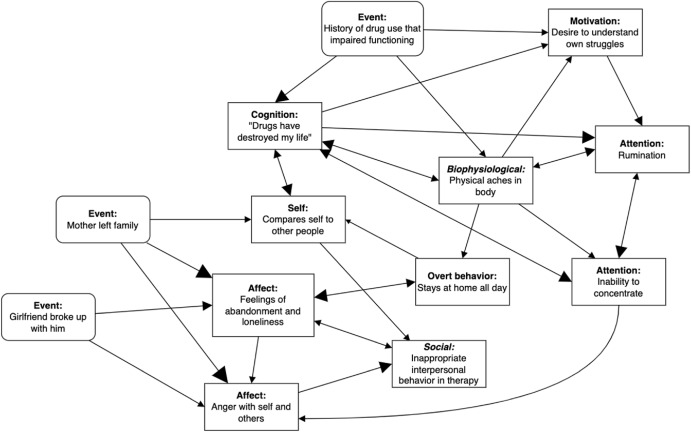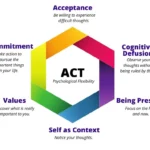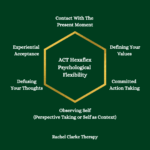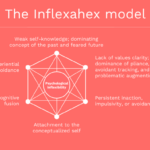ACT Hexaflex Model offers a unique approach toward psychological flexibility, which is becoming increasingly important in today’s fast-moving world where stress is a common challenge. The ACT Hexaflex Model focuses on six core processes that can help individuals grow as people, foster relationships, and maintain mental health. Whether you’re curious about how the ACT Hexaflex Model works or how to apply it in everyday life, this guide is for you.
What is the ACT Hexaflex Model?
The ACT Hexaflex Model shows the six critical processes involved in Acceptance and Commitment Therapy (ACT). Essentially, this model of cognitive-behavioral therapy emphasizes how one could develop further improved levels of psychological flexibility.
It shows a person how to concentrate his capabilities to build an ability to live a full and meaningful life. Graphically, the Hexaflex Model represents the approach, explaining how the six central processes interrelate and support one another.
Cognitive Defusion: A Key Element of the ACT Hexaflex Model
Cognitive defusion means noticing thoughts for what they are, just thoughts, not an ultimatum or absolute truth. This helps a person detach from unhelpful thoughts and reduces the impact of such thoughts on behavior.
Techniques of cognitive defusion help in observing thoughts driven by anxiety without getting caught in them. You may do such exercises, as saying this thought over and over again out loud until it loses some of its power.
Acceptance: Embracing What Is with the ACT Hexaflex Model
Acceptance means opening up completely to the present moment, including all feelings and thoughts, however undesirable they are. It’s not about liking the experience or wanting it. It’s just about not running, about not escaping from it.
Imagine feeling frustrated with something at work. Acceptance is acknowledging the frustration and allowing it to be, yet taking valued action in the face of it.
For that matter, it means a much healthier relationship with one’s emotions and thoughts, decreasing much struggle against them to save energy for other useful activities.
Mindfulness and Self-as-Context Techniques in the ACT Hexaflex Model
The ACT Hexaflex Model includes mindfulness as a key technique. It encourages an open, active, and attentive awareness of the present moment. This involves observing thoughts, feelings, and sensations with a non-judgmental attitude.
Self-as-context involves viewing yourself as more than just your thoughts and feelings. It’s the part of you that observes experiences without being defined by them. For example, instead of saying, “I am sad,” you can say, “I am noticing sadness.” This helps maintain the understanding that your identity is separate from your emotions.
How the ACT Hexaflex Model Enhances Well-being
The ACT Hexaflex Model promotes psychological flexibility, improving overall well-being. It encourages practicing mindfulness and committed action to stay grounded in your values.
When feeling stressed, engage in mindfulness activities like meditation or deep breathing. This brings attention to the present moment and reduces anxiety.
Building Stronger Relationships with the ACT Hexaflex Model
The ACT Hexaflex Model can improve relationships. Acceptance and self-awareness help improve communication and empathy.
For instance, during a disagreement, mindfulness and cognitive defusion can help you detach from negative thoughts. This allows for clearer, more balanced conversations, leading to healthier relationships.
Overcoming Psychological Inflexibility with the ACT Hexaflex Model
A major benefit of the ACT Hexaflex Model is overcoming psychological inflexibility. This happens when individuals become stuck in rigid thinking or avoidance behaviors.
The model encourages individuals to recognize and address inner struggles. Committed action helps keep you aligned with your values, even in the face of setbacks. This boosts resilience and psychological flexibility.
The ACT Hexaflex Model helps you stay open to change and present with difficult emotions, fostering emotional growth and mental well-being.
Applying the ACT Hexaflex Model in Daily Life
All six core processes can be practiced in real life to help develop psychological flexibility and foster overall well-being. The following are some helpful tips for bringing these elements into everyday living:
- Create time to become self-aware or mindful through meditation
- When unhelpful thoughts spring to mind, apply cognitive defusion by naming them as “thoughts” or repeating them out loud until their power is diminished.
- Practice acceptance by acknowledgment and allowance of difficult emotions to exist without trying to avoid or control them.
- Connect with your values and take action on their basis.
- Take small, esteemed steps toward your values in the face of obstacles or setbacks that you may encounter.
Practical Applications in Daily Life
The ACT Hexaflex Model is not just a theory; rather, it’s a very functional framework from which one can apply elements every day. Listed here are some ways to include these processes in your life:
Personal Growth:
- Practice Acceptance: Willingness to feel and accept, in case of confrontation with what is fear and how to overcome undesirable emotions. The Hexaflex Model can also help in cutting down stress and fear augmenting emotional resiliency.
- Use cognitive diffusion: Observe unhelpful thoughts not as something that is going by, but as a truth itself. This helps to keep focusing on how to achieve the goal.
Relationships:
- Attention: Always be an active listener and present while hearing from each other. This will improve bonding and, at the same time, reduce misunderstandings.
- Align your actions with your values: in relating to others at all times, always act as much as possible with compassion, truthfulness, and respect for the values you live for.
- Invest in Growth: Healthy relationships always require time and focused care. Even when the relationship gets tough, commit to activities that strengthen your relationship.
Mental Health
- Try a little mindfulness: The more one practices mindfulness, the greater the possibility of living in the present moment more groundedly, which in itself helps deal with anxiety and depression.
- Professional Help: If you want to apply the ACT Hexaflex Model effectively to deal with any kind of challenge that may come upon your mental health, then seek the support of a therapist who is trained for this under ACT.
- Focus on Self-as-Context: Remember, you are not your psychological struggles. Having a sense of yourself as an observer can lend to feelings of distance and thus promote control.
Conclusion
The ACT Hexaflex Model presents a totally specific and based method to decorate highbrow well-being and mental flexibility in an increasingly worrying world. By specializing in six core ideas: Cognitive Defusion, Acceptance, Mindfulness, Self-as-Context, Values, and Committed Action, the ACT Hexaflex Model encourages individuals to live greater significant lives by way of aligning with their values, accepting their thoughts and emotions without judgment, and performing in strategies congruent with the values of the one, even if demanding situations arise.
FAQ:
What does the ACT Hexaflex Model stand for?
The ACT Hexaflex Model is a framework in Acceptance and Commitment Therapy (ACT) that promotes six key methods: Cognitive Defusion, Acceptance, Mindfulness, Self-as-Context, Values, and Committed Action. It’s designed to foster mental flexibility, encouraging individuals to live via their values even while accepting and coping with difficult feelings and minds.
How does the ACT Hexaflex Model differ from traditional therapy models?
Unlike many traditional models that target symptom reduction, the ACT Hexaflex Model emphasizes mental flexibility and resilience through recognition, mindfulness, and values-guided actions. It’s about accepting thoughts without judgment, focusing on personal values, and staying committed to those values regardless of obstacles, which makes it distinctive from symptom-targeted therapy plans like traditional Cognitive Behavioral Therapy (CBT).











